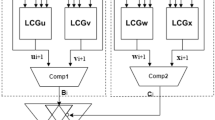Abstract
For the overall performance of systems like microprocessors and digital signal processors (DSPs) platforms, arithmetic units, all must be efficient in terms of speed, power, and area. Multipliers and dividers are inevitable hardware employed in such systems. This paper focuses on Vedic mathematics algorithms for multiplication and division for power-efficient, faster, and area-efficient design. For four- and eight-bit Vedic multiplication algorithms, Urdhva Tiryagbhyam and Nikhilam Sutras are employed in this paper. For eight-bit Vedic division algorithms, Nikhilam and Dhwajank Sutras are used. The Vedic mathematics algorithms are also compared to conventional methods of multiplication (like Array multiplier) and division (using Booth multiplication algorithm). As an application of DSP, the linear convolution operation is implemented using both conventional and Vedic algorithms. It has been observed that the Vedic algorithms operate faster, consume less power, and occupy less area on a targeted hardware platform. The implementations were carried out using the Verilog HDL language and Xilinx’s Vivado EDA tool. To measure various performance parameters, Cadence simvision (using 180-nm GPDK CMOS Technology) and Xilinx’s ISE tool were also used.



Similar content being viewed by others
References
Tadas A and Rotake D 2015 64 bit divider using vedic mathematics. In: Proceedings of the 2015 International Conference on Smart Technologies and Management for Computing, Communication, Controls, Energy and Materials (ICSTM), IEEE, pp. 317–320
Akhter S and Chaturvedi S 2019 Modified binary multiplier circuit based on vedic mathematics. In: Proceedings of the 2019 6th International Conference on Signal Processing and Integrated Networks (SPIN), IEEE, pp. 234–237
Kishor D R and Bhaaskaran V K 2014 Low power divider using vedic mathematics. In: Proceedings of the 2014 International Conference on Advances in Computing, Communications and Informatics (ICACCI), IEEE, pp. 575–580
Thakur K and Sharma T 2019 Area efficient high speed vedic multiplier. International Journal of Innovative Technology and Exploring Engineering 8(9S): 302–306
Akhter S, Saini V and Saini J 2017 Analysis of vedic multiplier using various adder topologies. In: Proceedings of the 2017 4th International Conference on Signal Processing and Integrated Networks (SPIN), IEEE, pp. 173–176
Batham N and Anjum S 2016 Algorithm for convolution operation in DFT using vedic multiplication. International Journal of Engineering Innovations and Research 5(5): 288–291
Toro S, Patil A, Chavan Y V, Patil S C, Bormane D S, and Wadar S 2016 Division operation based on vedic mathematics. In: Proceedings of the 2016 IEEE International Conference on Advances in Electronics, Communication and Computer Technology (ICAECCT), IEEE, pp. 450–454
Pichhode K, Patil M D, Shah D and Rohit B C 2015 FPGA implementation of efficient vedic multiplier. In: Proceedings of the 2015 International Conference on Information Processing (ICIP), IEEE, pp. 565–570
Sapkal K J and Shrawankar U 2017 Complexity analysis of vedic mathematics algorithms for multicore environment. International Journal of Rough Sets and Data Analysis 4: 31–47
Kumar A 2017 Comparative analysis of vedic and array multiplier. International Journal of Electronics and Communication Engineering and Technology 8(3): 17–27
Sriraman L and Prabakar T N 2012 Design and implementation of two variable multiplier using KCM and vedic mathematics. In: Proceedings of the 2012 1st International Conference on Recent Advances in Information Technology (RAIT), IEEE, pp. 782–787
Sudeep M C, Bimba M S, and Vucha M 2014 Design and FPGA implementation of high speed vedic multiplier. International Journal of Computer Applications 90(16): 10.5120/15802-4641
Prasada G S V, Seshikala G, and Sampathila N 2018 Performance analysis of 64\(\times \)64 bit multiplier designed using urdhva tiryakbyham and nikhilam navatashcaramam dashatah sutras. In: Proceedings of the 2018 IEEE Distributed Computing, VLSI, Electrical Circuits and Robotics (DISCOVER), IEEE, pp. 28–31
Prasada G S V, Seshikala G, and Niranjana S 2019 Design of high speed 32-bit floating point multiplier using urdhva triyagbhyam sutra of vedic mathematics. International Journal of Recent Technology and Engineering 8(2 special issue 3): 1064–1067
Rajani M and Sridevi N 2015 Survey on implementation of IEEE754 floating point number division using vedic techniques. International Journal of Engineering Development and Research 3(3)
Ugra Mohan Kumar S K, Singh M P, and Yadav A K 2017 Fast and efficient division technique using vedic mathematics in Verilog code. International Journal of Scientific and Engineering Research 8(10): 99–103
Punwantwar N R and Chatur P N 2015 Convolution and deconvolution using vedic mathematics. International Journal of Advanced Research in Electrical, Electronics, and Instrumentation Engineering 4(6): 5216–5223
Author information
Authors and Affiliations
Corresponding author
Rights and permissions
About this article
Cite this article
Biji, R., Savani, V. Performance analysis of Vedic mathematics algorithms on re-configurable hardware platform. Sādhanā 46, 83 (2021). https://doi.org/10.1007/s12046-021-01605-4
Received:
Revised:
Accepted:
Published:
DOI: https://doi.org/10.1007/s12046-021-01605-4




